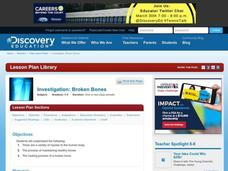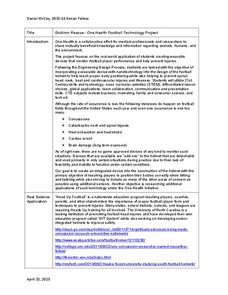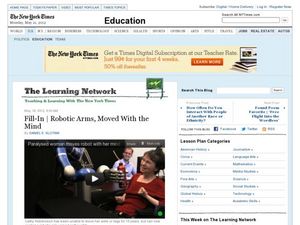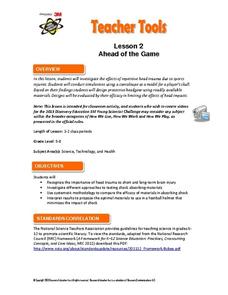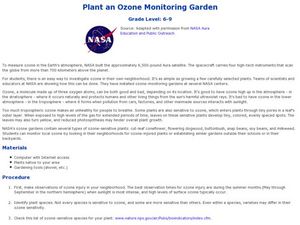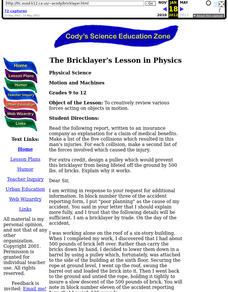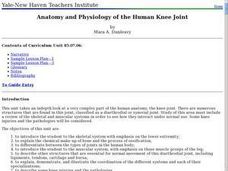Curated OER
Kids Negotiating the Electronic Superhighway-Self Care & Repetition Injuries
Students arrange, recognize and illustrate the connection of body movements to technology to injury. Students explore their findings to examine the statistics to their own personal lives. Students focus on a variety of resources to...
Curated OER
Broken Bones
Students examine a variety of injuries that can happen to the human body and discover the process of maintaining healthy bones. After discussing the process of bone repair following a break, they draw the process in cartoon style and...
Kenan Fellows
Gridiron Rescue: One Health Football Technology Project
Helmets not included! Scholars brainstorm adjustments and sensors to football helmets in an engineering design project to help prevent injuries, such as concussions and spinal injuries.
Curated OER
Goggle Safety
In this goggle safety worksheet, students describe different types of eye injuries. They observe pictures of eye injuries and list six different types. This one-page worksheet contains five problems.
Curated OER
Brain-Controlled Robotic Arms: Cloze activity with Article
Fascinating content about current medical research on brain-controlled prosthetics comes in cloze activity form with a link to the original article. Useful for listening and reading comprehension skills development, and for any science...
Discovery Education
Ahead of the Game
According to the movie Wildcats, "It's the sport of kings, better than diamond rings, football!" It is also, however, the sport of severe concussions and ongoing blows to the head. In order to keep our Seahawks soaring and Broncos...
It's About Time
Life (and Fewer Deaths) After Seat Belts
Seat belts reduce serious crash-related injuries and deaths by about half. Scholars continue crashing their cart with a crash test dummy into a wall, but this time, they experiment with different types of seat belts to reduce injuries....
BioEd Online
Good Stress for Your Body
Stress the importance of the different types of pressure our mind and body experience in a lesson about how certain types of stress are actually necessary and good for our bodies. As astronauts and people with injuries can attest, not...
Baylor College
Energy Sources
Take the concept of burning calories to a more literal level in the second of seven lessons about energy in the realm of food and fitness. Using simple materials, groups will burn breakfast cereal and a pecan to see which one gives off...
Curated OER
Skeletal System
Seventh graders explore the functions of the skeletal system. They collaborate in small groups to determine the function of the skeletal system, the types of joints and movement, bone strength and growth, and bone injuries including...
Curated OER
Feelin' Hot, Hot Hot!
Students explore human anatomy by researching first aid care. In this heat related injury lesson, students discuss the problems extreme temperatures can cause on the human body if left untreated. Students define the different injuries,...
It's About Time
Why Air Bags?
If a heavy steel car can't protect you from injury, how can a bag filled with air? The lesson answers this question and many others as young scientists experiment with the impulse and forces related to air bags in automobiles.
CK-12 Foundation
Hotpack - Coldpack
Chemistry can help athletes and others protect and treat injuries. Use the interactive activity to explore the chemical reactions in instant hot and coldpacks. Learners manipulate the type of salt in the pack and watch the reaction take...
Colorado State University
Why Do Raindrops Sometimes Land Gently and Sometimes with a Splat?
A mouse can fall from large heights without injury! Air resistance is a large influence on small falling objects. In an exploratory lesson, young scholars build a raindrop bottle to compare the falling rate of different-sized objects.
Chemistry Collective
Virtual Lab: Acid Dilution Problem
There's no risk of injury when working with virtual HCl! Challenge your young chemists with making calculations to create a 3M solution of HCl from the concentrated acid. They first calculate the correct ratios of HCl and water and then...
Howard Hughes Medical Institute
Neural Control of Walking and Running
Physical therapists state that relearning how to walk often motivates stroke and brain injury patients. Researchers spend a great deal of time focused on understanding the neural control required for walking. They pass along that...
Children’s Hospital of Philadelphia
Organs and Tissues of the Immune System
It's virus-fighting time! Pupils learn how viruses attack and reproduce and how the immune system works to protect the body. They identify unfamiliar terms and tissues and organs of the immune system. Working in small groups, scholars...
Curated OER
ASPIRIN (Assess Simulated Presentation Involving Realistic Injury Now)
Learners integrate biology and chemistry into a medical framework. They nterpret observations and data and evaluate their hypotheses in the light of the data obtained.. They make appropriate diagnosis and recommend treatment.
Curated OER
What Happened to Robin?
Students investigate animal injuries caused by humans. They present their findings to various neighborhood groups.
Curated OER
Head, Shoulders, Knees and Toes
Students gain a greater comprehension of the anatomy and physiology of the muscular system, the skeletal system and connective tissue by researching joints in the body. They also reflect on the effects of injuries on their joints and...
Curated OER
Biological Concepts
Students perform a transection of a redworm. They discuss spinal cord injuries in humans. Students compare the ability of the redworm to regenerate the ventral nerve cord with the inability of humans to repair damage to the dorsal nerve...
Curated OER
Plant an Ozone Monitoring Garden
Students create a garden. For this ozone lesson, students discuss ozone injury, identify plants sensitive to ozone, and then plant their own ozone garden.
Curated OER
The Bricklayer's Lesson in Physics
High schoolers read a simulated report, written to an insurance company as explanation for a claim of medical benefits. They list the collisions that resulted in the injuries, and identify the forces involved which caused the injury.
Curated OER
Anatomy and Physiology of the Human Knee Joint
Students examine human anatomy with a focus on the knee joint. In groups, they research the chemical makeup of human bones and explain the different types of joints found in the body. To end the lesson, they identify the other structures...
Other popular searches
- Sports Injuries
- Athletic Injuries
- Spinal Cord Injuries
- Bone Injuries
- Sports Medicine and Injuries
- Unintentional Injuries
- Sports Medicine Injuries
- Famous Sports Injuries
- Knee Injuries
- Athletes Injuries
- Top 10 Sports Injuries
- Assessing Sports Injuries



